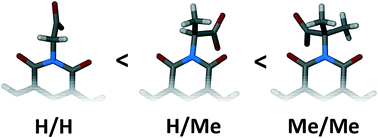Structural changes in coordination polymers in response to small changes in steric bulk (H vs. Me): an experimental and theoretical study†
Abstract
Changing the steric bulk on amino-acid substitued naphthalenediimide ligands is shown to dramatically alter their coordination chemistry by changing the preferred conformation of the ligand and hence the structural motifs that assemble. Naphthalenediimide ligands subsituted by glycine (GlyNDI) and aminoisobutyric acid (ibaNDI) have been investigated and contrasted to previous studies using analogous NDI ligands containing chiral amino acids (ααNDIs). Whilst coordination polymers containing ααNDIs form reproducible M2L2 metallomacrocyclic motifs, the materials reported here do not, despite only a small change in the steric bulk of the α-carbon substituents. Changing from N–CHR–CO2− terminii (for ααNDIs) to N–CH2–CO2− (GlyNDI) or N–CMe2–CO2− (ibaNDI) acts to reduce or increase the steric bulk immediately around the α-carbon, respectively. Seven coordination polymers containing GlyNDI (1–7) indicate a preference for the ligands to be closely packed in a parallel manner, and three coordination polymers containing ibaNDI (8–10) show interactions occuring between the NDI cores in a more perpendicular manner; none display the same motif that is observed for the vast majority of previously reported ααNDI-based materials. The reported GlyNDI and ibaNDI coordination polymers include attempts to force formation of macrocycles by forming rotaxane or catenane motifs using co-ligands. Computational studies, and structural comparisons, show that GlyNDI, ibaNDI and ααNDIs adopt different conformations of the carboxylate groups with respect to the NDI core, with the crystallographically observed conformations matching minimised geometries. These conformational differences are a property of the molecule and are not enforced by solid-state packing, showing that small steric changes can have subtle effects on molecular geometry that are observed as pronounced effects in crystal engineering. The previously used ααNDI ligands are therefore shown to have steric demands that are neither too great nor too small, and therefore occupy a ‘Goldilocks zone’ for the formation of a macrocyclic motif.



 Please wait while we load your content...
Please wait while we load your content...
